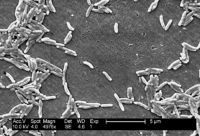Difference between revisions of "Campylobacter fetus subspecies venerealis"
| (5 intermediate revisions by 2 users not shown) | |||
| Line 1: | Line 1: | ||
| − | |||
{{Taxobox | {{Taxobox | ||
|name =''Campylobacter fetus'' | |name =''Campylobacter fetus'' | ||
| Line 6: | Line 5: | ||
|order =Campylobacterales | |order =Campylobacterales | ||
|family =Campylobacteraceae | |family =Campylobacteraceae | ||
| − | |genus = | + | |genus =Campylobacter |
|species =''C.fetus'' | |species =''C.fetus'' | ||
|subspecies =''venerealis'' | |subspecies =''venerealis'' | ||
}} | }} | ||
==Introduction== | ==Introduction== | ||
| − | [[File: | + | [[File:campylo.jpg|thumb|200px|right|''Campylobacter fetus'' Janice Carr 2004, wikimedia commons]] |
| − | ''Campylobacter fetus'', has the subspecies [[Campylobacter fetus subspecies fetus|''fetus'']] and ''venerealis'', belonging to the genus [[Campylobacter species - Overview|''Campylobacter'']]. ''Campylobacter fetus subsp. venerealis'' causes | + | ''Campylobacter fetus'', has the subspecies [[Campylobacter fetus subspecies fetus|''fetus'']] and ''venerealis'', belonging to the genus [[Campylobacter species - Overview|''Campylobacter'']]. ''Campylobacter fetus subsp. venerealis'' causes venereal infection in cattle and infertility in female cattle. |
| − | + | Bulls are carriers of the disease as they show no clinical signs but bacteria can be found in the glandular crypts of the bulls prepuce. ''Campylobacter fetus subsp. venerealis'' is therefore spread by coitus or rarely by artificial insemination. It causes catarrhal inflammation in the female genital tract, temporary infertility and prolonged oestrus cycle. [[Endometritis]] prevents implantation until the infection is cleared and causes early embryonic death and occasionally sporadic abortion. | |
| − | |||
| − | |||
The cow may remain infertile for 3-5 months before immunity develops, which then lasts 4-5 years. Effective immunity includes induction of [[IgA]] in the vagina and [[IgG]] in the uterus. | The cow may remain infertile for 3-5 months before immunity develops, which then lasts 4-5 years. Effective immunity includes induction of [[IgA]] in the vagina and [[IgG]] in the uterus. | ||
The bacteria may persist in the vagina and be transmitted to bulls. | The bacteria may persist in the vagina and be transmitted to bulls. | ||
==Diagnosis== | ==Diagnosis== | ||
| − | A | + | A fluorescent antibody test on genital discharges from the bull or cow can be diagnostic. A vaginal mucus agglutination test can be done. |
| − | + | An ELISA to [[IgA]] antibodies in vaginal mucus after an abortion can be done in the cow, or PCR for detection in semen. | |
| − | An | ||
==Treatment== | ==Treatment== | ||
| Line 28: | Line 24: | ||
A vaccination of bacterin in oil adjuvant can also be done. | A vaccination of bacterin in oil adjuvant can also be done. | ||
| − | + | ==Literature Search== | |
| − | + | [[File:CABI logo.jpg|left|90px]] | |
| − | |||
| − | |||
| − | |||
| + | Use these links to find recent scientific publications via CAB Abstracts (log in required unless accessing from a subscribing organisation). | ||
| + | <br><br><br> | ||
| + | [http://www.cabdirect.org/search.html?rowId=1&options1=AND&q1=%22Campylobacter+fetus+subspecies+venerealis%22&occuring1=freetext&rowId=2&options2=OR&q2=%22Campylobacter+fetus+subsp.+venerealis%22&occuring2=freetext&rowId=3&options3=AND&q3=&occuring3=freetext&publishedstart=yyyy&publishedend=yyyy&calendarInput=yyyy-mm-dd&la=any&it=any&show=all&x=46&y=11 ''Campylobacter fetus'' subspecies ''venerealis''] | ||
| + | [http://www.cabi.org/cabdirect/FullTextPDF/2008/20083052195.pdf ''' Bovine venereal campylobacteriosis: an overview.''' Mshelia, G. D.; Singh, J.; Amin, J. D.; Woldehiwet, Z.; Egwu, G. O.; Murray, R. D.; CABI, Wallingford, UK, CAB Reviews: Perspectives in Agriculture, Veterinary Science, Nutrition and Natural Resources, 2007, 2, 080, pp 14 ., 175 ref. - '''Full Text Article'''] | ||
| − | |||
| + | {{review}} | ||
[[Category:Campylobacter species]] | [[Category:Campylobacter species]] | ||
[[Category:Cattle Bacteria]] | [[Category:Cattle Bacteria]] | ||
| − | [[Category: | + | [[Category:Jaimie Meagor]] |
Revision as of 18:06, 8 June 2011
| Campylobacter fetus | |
|---|---|
| Phylum | Proteobacteria |
| Class | Epsilon Proteobacteria |
| Order | Campylobacterales |
| Family | Campylobacteraceae |
| Genus | Campylobacter |
| Species | C.fetus |
Introduction
Campylobacter fetus, has the subspecies fetus and venerealis, belonging to the genus Campylobacter. Campylobacter fetus subsp. venerealis causes venereal infection in cattle and infertility in female cattle. Bulls are carriers of the disease as they show no clinical signs but bacteria can be found in the glandular crypts of the bulls prepuce. Campylobacter fetus subsp. venerealis is therefore spread by coitus or rarely by artificial insemination. It causes catarrhal inflammation in the female genital tract, temporary infertility and prolonged oestrus cycle. Endometritis prevents implantation until the infection is cleared and causes early embryonic death and occasionally sporadic abortion. The cow may remain infertile for 3-5 months before immunity develops, which then lasts 4-5 years. Effective immunity includes induction of IgA in the vagina and IgG in the uterus. The bacteria may persist in the vagina and be transmitted to bulls.
Diagnosis
A fluorescent antibody test on genital discharges from the bull or cow can be diagnostic. A vaginal mucus agglutination test can be done. An ELISA to IgA antibodies in vaginal mucus after an abortion can be done in the cow, or PCR for detection in semen.
Treatment
Dihydrostreptomycin intrauterine for cows and systemically or topically for bulls. A vaccination of bacterin in oil adjuvant can also be done.
Literature Search
Use these links to find recent scientific publications via CAB Abstracts (log in required unless accessing from a subscribing organisation).
Campylobacter fetus subspecies venerealis
| This article has been peer reviewed but is awaiting expert review. If you would like to help with this, please see more information about expert reviewing. |

